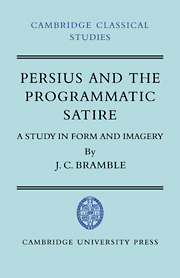Book contents
- Frontmatter
- Contents
- PARENTIBUS OPTIMIS
- Preface
- Abbreviations
- INTRODUCTION
- 1 STYLE AND EXPRESSION IN PERSIUS' FIFTH SATIRE
- 2 THE PROGRAMMATIC SATIRE AND THE METHOD OF PERSIUS I
- 3 THE NATURE AND SOURCES OF PERSIUS' IMAGERY
- 4 PERSIUS' FIRST SATIRE: ANALYSIS
- 5 GRANDEUR AND HUMILITY: JUVENAL AND THE HIGH STYLE
- APPENDIX 1 Accius and Pacuvius at Persius I. 76–8
- APPENDIX 2 Virgil and the moderns at Persius I. 96
- APPENDIX 3 The image of the child in ancient satire and diatribe
- APPENDIX 4 The disclaimer of malice
- TEXT
- TRANSLATION
- 1 INDEX OF MODERN AUTHORS
- 2 INDEX LOCORUM POTIORUM
- 3 INDEX OF IMAGES, TOPICS AND WORDS
2 - THE PROGRAMMATIC SATIRE AND THE METHOD OF PERSIUS I
from PARENTIBUS OPTIMIS
Published online by Cambridge University Press: 05 June 2014
- Frontmatter
- Contents
- PARENTIBUS OPTIMIS
- Preface
- Abbreviations
- INTRODUCTION
- 1 STYLE AND EXPRESSION IN PERSIUS' FIFTH SATIRE
- 2 THE PROGRAMMATIC SATIRE AND THE METHOD OF PERSIUS I
- 3 THE NATURE AND SOURCES OF PERSIUS' IMAGERY
- 4 PERSIUS' FIRST SATIRE: ANALYSIS
- 5 GRANDEUR AND HUMILITY: JUVENAL AND THE HIGH STYLE
- APPENDIX 1 Accius and Pacuvius at Persius I. 76–8
- APPENDIX 2 Virgil and the moderns at Persius I. 96
- APPENDIX 3 The image of the child in ancient satire and diatribe
- APPENDIX 4 The disclaimer of malice
- TEXT
- TRANSLATION
- 1 INDEX OF MODERN AUTHORS
- 2 INDEX LOCORUM POTIORUM
- 3 INDEX OF IMAGES, TOPICS AND WORDS
Summary
It was common practice for the Roman satirist to give an account of his genre, arraigning public vice, perhaps ridiculing the insufficiencies of the other literary forms, and informing the reader of the tone which he himself intended to adopt. The vehicle for this account was the programmatic satire. It is quite clear that Horace Satires II. I, Persius I, and Juvenal I are related compositions. Their shared features have been duly discussed in the secondary literature. Noting that a scholiast entitles Juvenal's first satire cur satiras scribat, also the corresponding formal characteristics of the three programmes, L. R. Shero concludes: ‘Each of the satires is constructed upon a traditional framework; and we may reasonably conclude that a satire of this type, ostensibly justifying the writing of satire by means of conventional devices and stock arguments, came to be looked upon as an indispensable feature of the satirist's stock-in-trade.’ More recently, E. J. Kenney has detected the following ‘pattern of apology’: ‘First, a pronouncement, lofty to the point of bombast, of the satirist's high purpose and mission. Second, a warning by a friend or the poet's alter ego or the voice of prudence – call it what you will. Third, an appeal by the satirist to the great example of Lucilius. Fourth, a renewed warning. Fifth and last, evasion, retraction and equivocation.’ But similarities apart, there is a marked degree of divergence in procedure. It is this – innovation within convention – which will occupy my attention.
- Type
- Chapter
- Information
- Persius and the Programmatic SatireA Study in Form and Imagery, pp. 16 - 25Publisher: Cambridge University PressPrint publication year: 1974
- 1
- Cited by

